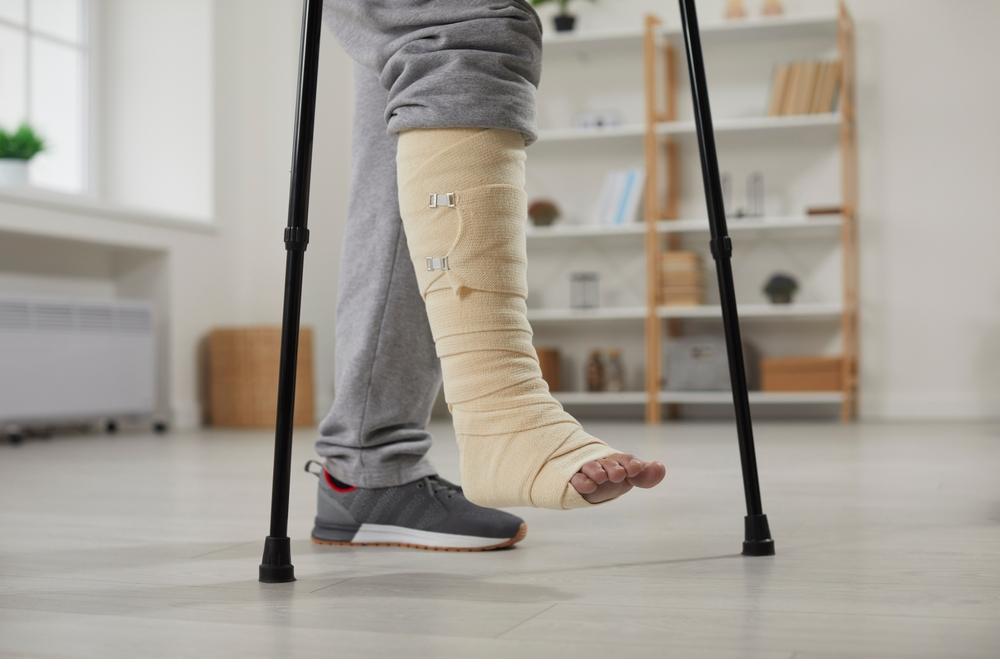 A hairline fracture refers to a specific type of broken bone where small cracks or thinning of the bone occurs. In fact, unlike other types of broken bones, it is possible to have a hairline fracture and not know it. When small cracks or thinning first occur, they may not cause noticeable symptoms in some people. However, there are certain signs to look out for when it comes to a potential hairline fracture injury. One of the most common places to suffer a hairline fracture is in the ankle joint. A hairline ankle fracture is a type of broken ankle that can cause pain, swelling, and tenderness on the affected foot. Here’s everything you need to know about how to deal with a hairline ankle fracture.
A hairline fracture refers to a specific type of broken bone where small cracks or thinning of the bone occurs. In fact, unlike other types of broken bones, it is possible to have a hairline fracture and not know it. When small cracks or thinning first occur, they may not cause noticeable symptoms in some people. However, there are certain signs to look out for when it comes to a potential hairline fracture injury. One of the most common places to suffer a hairline fracture is in the ankle joint. A hairline ankle fracture is a type of broken ankle that can cause pain, swelling, and tenderness on the affected foot. Here’s everything you need to know about how to deal with a hairline ankle fracture.
Hairline Fractures vs. Stress Fractures
Hairline fractures and stress fractures are terms often used interchangeably to refer to small cracks in the bone. These typically occur because of overuse or repetitive stress on one or more bones. When the bone is subjected to repeated stress over time, this can cause the bone to crack or thin. The main difference between a hairline fracture and a stress fracture is the size of the broken bone. A hairline fracture is typically smaller and may not even appear on an X-ray. A stress fracture can be larger, which makes it more likely to show up on an X-ray. To diagnose or rule out a hairline fracture, a more detailed diagnostic imaging tool like a CT scan or MRI may be necessary to see this type of broken bone.
Causes of Ankle Hairline Fractures
 The most common cause of a hairline fracture to the ankle is overuse or repetitive impact on the joint. However, there are other potential causes for an ankle hairline fracture that can impact the type of treatment you need to fully recover. Here are five examples of what could cause a hairline ankle fracture.
The most common cause of a hairline fracture to the ankle is overuse or repetitive impact on the joint. However, there are other potential causes for an ankle hairline fracture that can impact the type of treatment you need to fully recover. Here are five examples of what could cause a hairline ankle fracture.
Overuse
An overuse injury can occur when you do the same activity over and over again without getting enough rest in between. For your ankles and feet, this can include walking or running long distances without taking sufficient breaks to give your body a chance to recover.
Repetitive Impact
The repetitive impact on the ankle joint can also result in a hairline fracture. Common repetitive impact activities that may cause a hairline ankle fracture include running and jumping, especially on hard surfaces.
Improper Technique
If you use improper technique while participating in a sport or activity, you increase your risk for injury, including a hairline fracture. For example, improper technique while running can put excess stress on the bones of your ankle.
Improper Footwear
The type of shoes you wear can also negatively impact you. Improper footwear that does not provide adequate support or cushioning can increase your risk for a hairline ankle fracture while engaging in repetitive activities.
Weak Bones
People with health conditions that result in weakened bones can also become more susceptible to hairline fractures. For example, a person with osteoporosis who enjoys running daily could be at greater risk for a hairline ankle fracture.
Poor Nutrition
A lack of proper nutrients, like calcium and vitamin D, can also lead to weakened bones and increase your risk for a hairline fracture.
Symptoms of a Hairline Ankle Fracture
A hairline fracture is so small that it may not even show up on an X-ray, but that doesn’t mean it isn’t a painful and uncomfortable injury. In fact, a hairline ankle fracture can cause a wide range of symptoms.
Pain
The most common symptom of a hairline ankle fracture is pain. Pain can range from mild to severe and typically gets worse when you put weight on the affected ankle and foot. You might not notice the pain at first, or your pain could get worse if the hairline fracture continues to crack.
Swelling
A hairline ankle fracture can also cause your ankle to swell. Swelling around the ankle joint, particularly on the outer or inner side of the ankle, is a sign of injury. A swollen ankle can make pain and other symptoms worse.
Tenderness
You may also notice that your ankle is tender to the touch. Tenderness around the fracture can occur because the inflamed tissues that support the ankle become more sensitive.
Bruising
Depending on the location and severity of the fracture, you may notice bruising around the ankle. A bruise is caused by bleeding under the skin, which could signal that the hairline fracture has damaged nearby blood vessels. Not all hairline fractures will result in bruising.
Limping
When you experience pain and discomfort from an ankle injury, you may find it difficult to walk or bear weight on the affected foot. You may also feel like the ankle is unstable. Both pain and instability of the ankle joint could cause you to walk with a limp.
Diagnosing an Ankle Hairline Fracture
 If you have an ankle injury, you want to visit your Jonesboro orthopedic doctor to get a proper diagnosis. The following are some common methods your orthopedic doctor may use to diagnose a hairline ankle fracture.
If you have an ankle injury, you want to visit your Jonesboro orthopedic doctor to get a proper diagnosis. The following are some common methods your orthopedic doctor may use to diagnose a hairline ankle fracture.
Physical Examination
Your orthopedist will examine your ankle and ask about what symptoms you have experienced. They will also want to know if you can pinpoint a cause for the injury. During the physical exam, they will also check for swelling, bruising, and tenderness to the touch.
Medical History
A thorough medical history will provide your doctor with relevant information to diagnose your specific ankle injury. A family history of a condition like osteoporosis or a previous injury to the area could help your doctor determine the best course of action. Your medical history can also impact how you recover from an ankle injury like a hairline fracture. Certain medical conditions or previous injuries can result in weakened or less stable joints. Certain medications can also weaken bones and put you at greater risk for injury.
Diagnostic Imaging Tools
Doctors also use state-of-the-art diagnostic imaging tools to get a better look at the affected ankle. An X-ray is a common imaging test that will show the bones of your ankle. Because a hairline fracture can be such a small crack in the bone, it may not always show up on a regular X-ray. A CT scan uses X-rays and a computer to create more detailed images of the bones in your ankle, which could also confirm a hairline fracture or get a better view of the fracture. An MRI uses a magnetic field and radio waves to create detailed images of the bones in your ankle, along with soft tissues like muscles, tendons, and ligaments nearby.
Treating a Hairline Ankle Fracture
The treatment options for a hairline ankle fracture will depend on the severity of the fracture and your individual needs. In many cases, non-surgical treatment options can be used to manage the injury. Here are some examples of treatment options for a hairline ankle fracture:
RICE Method
The RICE method stands for Rest, Ice, Compression, and Elevation. Resting is a key part of healing and recovery. Resting the affected ankle will allow the bone time to heal. You may also need to use crutches or a walker to avoid putting too much weight on the affected foot. Applying ice to the ankle can help reduce swelling and inflammation. Ice can also provide a temporary numbing sensation to help with the pain. Compression refers to wrapping the ankle with an elastic bandage, which helps to reduce swelling. Elevating the ankle above the level of your heart can also help reduce swelling.
Pain Management
You may also take over-the-counter pain medications like non-steroidal anti-inflammatory drugs to help with pain and inflammation. In some cases, your doctor may prescribe medications to help with the pain. Chiropractic care and non-invasive treatments can also help with pain management.
Physical Therapy
Physical therapy plays a significant role in your healing and recovery from an ankle injury. Your physical therapist can provide you with stretches, exercises, and other techniques to help strengthen the muscles around the ankle. Physical therapy aims to improve your mobility in the area by addressing strength, flexibility, balance, and coordination.
Surgery
In rare cases, a hairline ankle fracture may require surgery. Surgical procedures for a hairline ankle fracture could involve placing screws, plates, or other hardware to hold the bones in place while the ankle heals. A bone graft involves using a piece of bone from another part of the body to fill the gap created by the fracture to help promote healing and restore strength.
When to See a Doctor for Ankle Pain
Visit your Jonesboro orthopedic doctor if you suspect a hairline ankle fracture or another type of ankle injury. At AICA Orthopedics in Jonesboro, our team of doctors includes orthopedic surgeons and physical therapists who can diagnose and treat your ankle injury. We will support you through the healing and recovery process from a hairline ankle fracture so you can return to the activities you love.
